There were times when a considerable amount of the basic utility motorcycles, such as the Yamaha RD 135, relied on 2-stroke engines due to their low manufacturing cost and perceived ease of maintenance. Even though the lack of a valvetrain and the lube method based on oil consumption along the fuel have led to the perception of an easier maintenance compared to some 4-stroke engines with a chain-driven overhead cam, prompting Honda to respond with the CG 125 with a gear-driven overhead-valve layout which stood better to longer-than-recommended intervals between oil changes. Unlike other third-world countries where 2-strokes remained widely accepted among a broader public in the small-displacement segments, the Honda CG 125 quickly became a market leader in Brazil where it was launched in '76.
While the 4-stroke layout would ultimately become more widely accepted from an utilitarian standpoint and become mainstream, truth be said much for influence of the Honda CG 125 and in recent years all the unlicensed copies from China, the 2-stroke still retained a foothold among users who perceived it as a somewhat sportier alternative for those who value a more spirited riding experience, be it in a basic model such as the Yamaha RD 135 or in a real beast like the RD 350 LC. Tightening emission laws are often pointed out to have pulled the plug on the 2-stroke engine option for conventional motorcycles, in times when carburettors were still the rule instead of an exception, and the nature of 2-strokes which rely on the overlap of the intake and exhaust flows for scavenging renders it even more difficult to deal with. Even with the fitment of expansion chambers on the exhaust pipe, an attempt to retain more of the intake charge for a complete combustion through pressure differences as a makeshift to compensate for the lack of exhaust valves, the porting overlap is even more critical than the valve overlap on 4-strokes.
What may be considered relevant when it comes to the emissions concern as a reason for the phaseout of 2-stroke motorcycles is the Piaggio Vespa PX 150 having been available brand-new until 2016 while being certified into the Euro-3 emission standards and still carburettor-fed, meanwhile electronic fuel injection was already mainstream among its 4-stroke contenders. Sure it would not be rocket-science to fit it with EFI too, either a direct-injection setup which would require a different cylinder head cast or a port-injection layout now used by KTM in some of its 2-stroke enduro motorcycles that are even Euro-4 compliant. Considering the Vespa, naturally a more restrictive porting in order to decrease the loss of unburnt air/fuel mixture through the port overlap was as relevant as the catalytic converter to achieve an emissions compliance, despite being clearly detuned compared to previous model-years not subjected to this very same level of environmental scrutiny.
While any explicit ban on 2-stroke motorcycles has not been enforced in Brazil, and I do hope it never happens, neighboring countries such as Colombia already have such measures in some cities, including Bogotá, sparking controversies not only among many people who used old and beaten-down Japanese motorcycles but also enthusiasts of classic models such as the Vespa who nowadays have a much more leisure-oriented profile in contrast to its utilitarian origins when the austerity of the immediate post-war years called for affordable transportation. Probably some random brain-dead leftie would claim a Vespa owner who could rely on any modern 4-stroke scooter should eventually become liable to extra taxation as some supposed compensation for a claimed environmental damage and eventually fund subsidies for a replacement of 2-stroke motorcycles with newer 4-stroke ones or eventually engine retrofits allowing older models to remain allowed on the streets, but it's an oversimplifying approach which ignores some technical aspects. Besides an eventual usage of synthetic lube oils which decrease noticeably that thick blue cloud often seen from the exhaust pipe of a 2-stroke ride, models not fitted with an automatic lube system through oil injection from a separate reservoir also work with vegetable-based lube oils which even blend more effectively with the ethanol added to the gasoline in so many countries nowadays for example, already leading to a noticeable decrease on particulate matter emissions due to an incomplete combustion of oil and spark plug fouling.
Even though it may seem quite obvious that a 2-stroke carburettor-fed Vespa would consume more fuel and have higher emissions than, lets's say, a Brazilian Honda Pop 110i, and looking at it from a merely economic standpoint the 4-stroke fuel-injected Honda would seem to be better for those who look for a simple and utilitarian approach, but it should be taken with a grain of salt when a so-called emissions enforcement becomes a threat to individual freedoms. Just like recently enacted stricter restrictions on Diesel vehicles in some European cities are technically objectionable somehow, comparable attempts toward spark-ignited 2-stroke engines in Latin America and Asia ignore other measures which could be more reasonable. So, even though it may seem quite simple, a ban on 2-stroke motorcycles is not really an effective option to deal with air pollution as it might seem at a first glance.










No comments:
Post a Comment
Only comments written in English are published. Not so rigid about the grammar, but some regional slang should be avoided to make it clear and easily understandable.